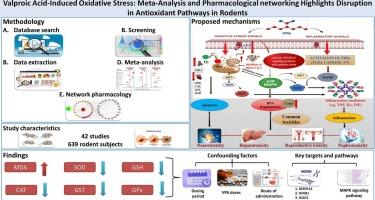Valproic acid-induced oxidative stress: Systematic review, meta-analysis and network pharmacology highlights disruption in antioxidant pathways in rodents
IF 3.4
3区 医学
Q2 PHARMACOLOGY & PHARMACY
引用次数: 0
Abstract
Valproic acid (VPA) is a widely used antiepileptic drug, but its effects on oxidative stress in rodent models have not been systematically reviewed. This meta-analysis aimed to evaluate the impact of VPA on oxidative stress markers in rodents and explore underlying mechanisms through network pharmacology. A systematic search of PubMed, Web of Science, and PsycINFO (2010–2024) was conducted, following PRISMA and CAMARADES guidelines. Forty-two studies involving 639 rodents were included. Meta-analysis and meta-regression were performed using SPSS and R, and network pharmacology identified key pathways. From 1802 studies, 42 met the criteria, involving 639 rodents. VPA treatment was associated with a significant increase in malondialdehyde (MDA) levels (SMD = 30.45, 95 % CI: 17.64–43.25, P < 0.001) and a decrease in clinically relevant biomarkers, such as superoxide dismutase (SOD) (SMD = −13.22, 95 % CI: −19.39–-7.04, P < 0.001), glutathione (GSH) (SMD = −16.97, 95 % CI: −28.13–-5.82, P < 0.001), catalase (CAT) (SMD = −9.24, 95 % CI: −13.85–-4.62, P < 0.001), glutathione S-transferases (GST) (SMD = −8.82, 95 % CI: −17.40–-0.24, P = 0.040), and glutathione peroxidase (GPx) (SMD = −36.05, 95 % CI: −60.72–-11.37, P < 0.001). Meta-regression analysis suggested that dosing periods and doses significantly impacted oxidative stress markers. Network pharmacology analysis identified 33 key targets and significant pathways, including MAPK signaling, Toll-like receptor signaling, and TNF signaling. VPA induces oxidative stress in rodent models by increasing MDA and reducing antioxidants, suggesting potential oxidative stress-related side effects in patients.

丙戊酸诱导的氧化应激:系统综述、荟萃分析和网络药理学突显了啮齿动物抗氧化途径的紊乱。
丙戊酸(VPA)是一种广泛使用的抗癫痫药物,但它对啮齿类动物模型中氧化应激的影响尚未得到系统回顾。本荟萃分析旨在评估 VPA 对啮齿类动物氧化应激指标的影响,并通过网络药理学探索其潜在机制。按照 PRISMA 和 CAMARADES 指南,对 PubMed、Web of Science 和 PsycINFO(2010-2024 年)进行了系统检索。共纳入 42 项研究,涉及 639 只啮齿动物。使用 SPSS 和 R 进行了元分析和元回归,并通过网络药理学确定了关键通路。在 1802 项研究中,有 42 项符合标准,涉及 639 只啮齿动物。VPA 治疗与丙二醛(MDA)水平的显著增加有关(SMD = 30.45,95 % CI:17.64-43.25,P
本文章由计算机程序翻译,如有差异,请以英文原文为准。
求助全文
约1分钟内获得全文
求助全文
来源期刊
CiteScore
6.80
自引率
2.60%
发文量
309
审稿时长
32 days
期刊介绍:
Toxicology and Applied Pharmacology publishes original scientific research of relevance to animals or humans pertaining to the action of chemicals, drugs, or chemically-defined natural products.
Regular articles address mechanistic approaches to physiological, pharmacologic, biochemical, cellular, or molecular understanding of toxicologic/pathologic lesions and to methods used to describe these responses. Safety Science articles address outstanding state-of-the-art preclinical and human translational characterization of drug and chemical safety employing cutting-edge science. Highly significant Regulatory Safety Science articles will also be considered in this category. Papers concerned with alternatives to the use of experimental animals are encouraged.
Short articles report on high impact studies of broad interest to readers of TAAP that would benefit from rapid publication. These articles should contain no more than a combined total of four figures and tables. Authors should include in their cover letter the justification for consideration of their manuscript as a short article.

 求助内容:
求助内容: 应助结果提醒方式:
应助结果提醒方式:


